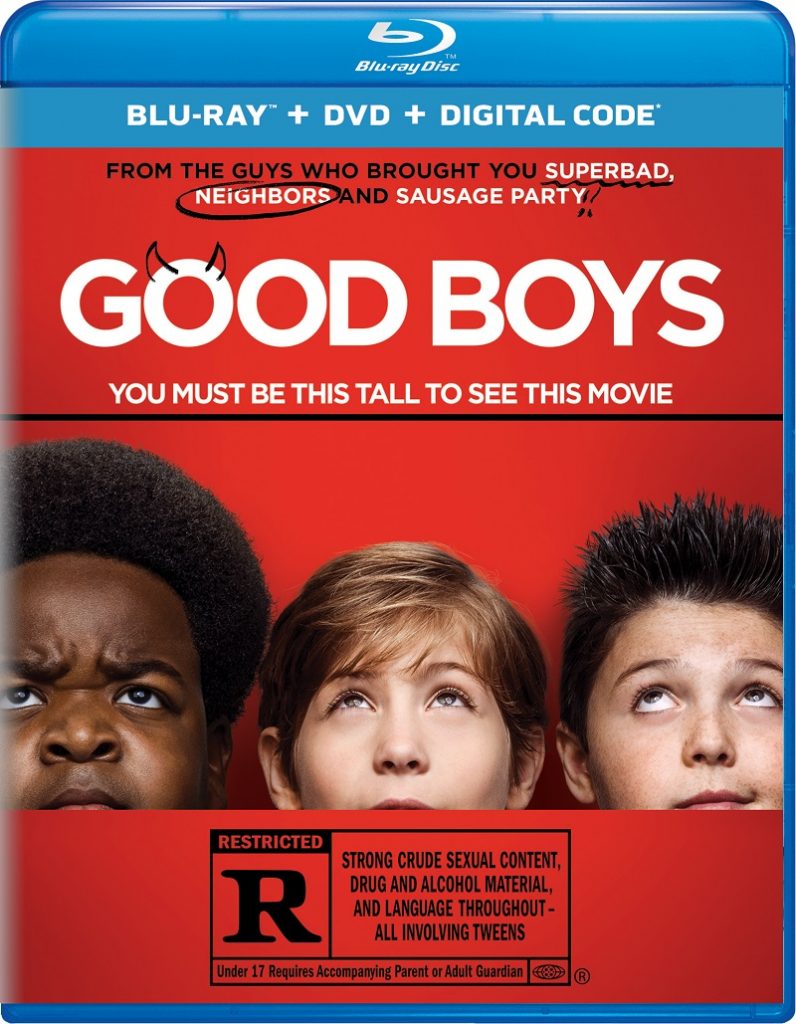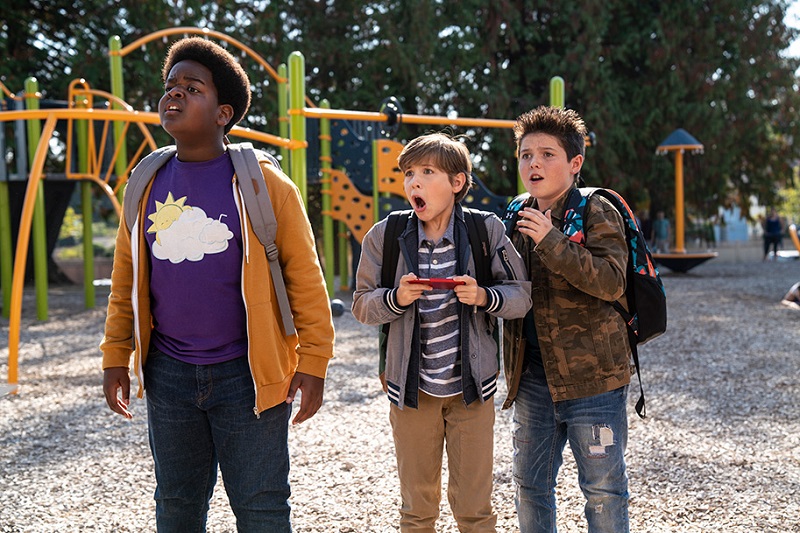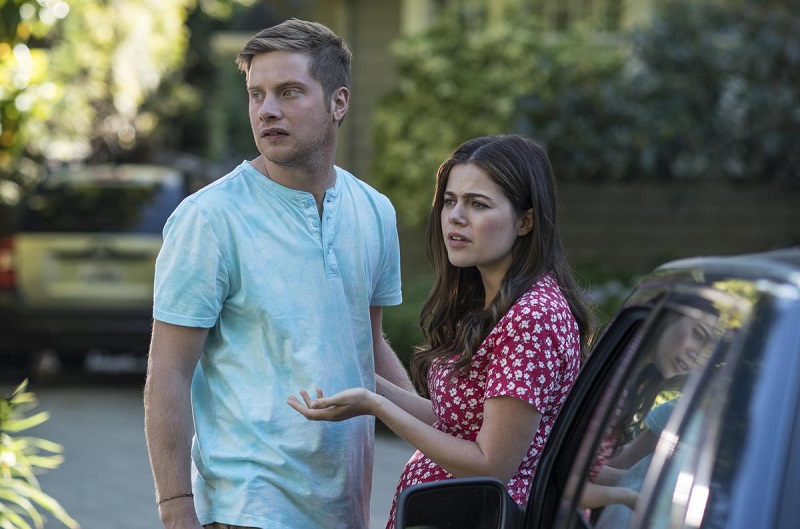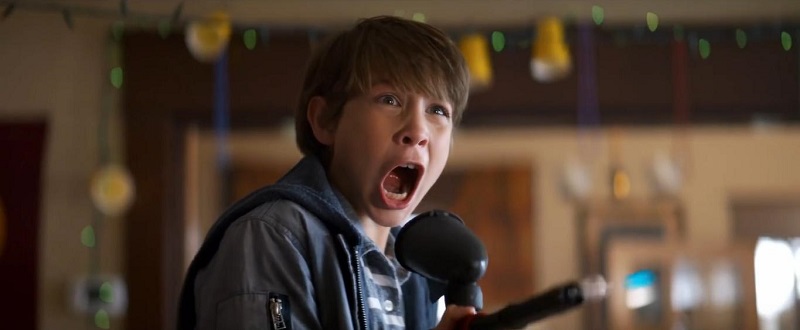From the moment that first Good Boys trailer premiered, buzz shot through the roof. Then, it premiered at South by Southwest festival in March and that only fanned the flames of anticipation. Here it is nine months later, and audiences can dive into the continually hilarious and surprisingly endearing slice of entertainment at home on DVD, Blu-Ray, digital and On Demand. And yes, you’re going to want to bring these fellas home to relive the hilarity over and over, but also to take your time and explore the bevy of bonus features that enhance the entire experience.

When the Oscar winning Room landed in theaters 2015—besides providing the forum for a dazzling turn by Brie Larson (that won her that Academy Award)—the heart searing drama served as the most extraordinary of talent showcases from a young thespian. Jacob Tremblay literally stole the show from his co-star and the world was put on notice that the most innate of gifted performers had arrived. Fast forward to this week and after supporting work on films such as The Predator and another breakout lead performance with Wonder, the actor is back with Good Boys … and boy oh boy is he good. For that matter, so is everyone else in this comedy that will have you LOLing all the way through.
It’s the beginning of a new school year and BFFs for life Max (Tremblay), Lucas (Keith L. Williams) and Thor (Brandy Noon) have been invited to a party at the leader of the “cool kids,” Soren (Izaac Wang). This is not simply a fete that features music, dancing, tasty beverages and pizza. Soren is throwing a “kissing party.” After the excitement of being stoked that they were asked to attend, reality sets in … they have no idea how to kiss. What’s a trio of tweens to do? After getting nowhere online by searching porn, they decide to turn their attention to the real world. That means taking the drone owned by Max’s dad (Will Forte) and sending it into the skies to spy on their neighbor Hannah (Molly Gordon) who they believe will be kissing her boyfriend or perhaps her BFF, Lily (Midori Francis). Sadly, the drone winds up in the hands of Hannah, who is none too pleased about being spied on by her neighbors.
The boys head over to Hannah’s house, tail between their legs, asking for forgiveness for invading their space and that the drone be returned. See, Max’s dad is coming home from a business trip and the clock is ticking. That drone needs to be back on its charging carousel by that time. If no drone, no party and no kissing for Max with his major crush. Things get complicated when the girls refuse to give back the drone and Thor snatches Hannah’s purse—that just happens to not only have her phone, wallet and the sort. But a few hits of Molly that she and Lily were planning to take on this fine day that suddenly has gone down the drain.
It seems like the simplest of premises, yet in the hands of director Gene Stupnitsky—working from a script co-written by him and Lee Eisenberg—there are the richest of layers to the film on a myriad of levels.
This is a film from the “guys who gave you Superbad.” For those expecting a similar flick, forget it. This is wildly different in so many ways. Yet one could easily call it a cinematic cousin of the comedy classic. Seth Rogen serves as a producer while his frequent partner in crime, Jonah Hill, is one of the executive producers. Their comedic sensibilities are all over this film, yet there is something extraordinarily unique about Good Boys that allows it to stand all on its own when compared to everything that Hill and Rogen have brought audiences’ way. All involved have the firmest of grasps on what it is like to be a 12-year-old whose world is drastically altering by the day and command of everything from your body, your emotions and even your changing voice, seems to be outside of the realm of your control. It is captured so luminously in Good Boys that had to be the most welcomed of surprises.
What else was astonishing was how the emotional ebbs and flows played an enormous part in the 90-minute joyride through what it means to be knocking on teen-dom’s door. Filmmakers have woven a web that, although they cannot see it because of it’s hard-R rating, in some ways could serve as a road map for tweens in how to usher in those wildly wicked teenage years. There is an enormous difference between those elementary school grades (here that means K through fifth grade) and junior high (sixth through eighth). The way the kids are growing up today, it is no wonder that so many school districts have changed from the middle school format that was solely seventh and eighth grade and now includes sixth graders. The societal, parental and peer pressure on these kids makes them feel as if challenging change is literally a 360-degree concern. In Good Boys, that is handled so intuitively that it makes one wonder if the writers managed to discover a time machine and went back to those days of their youth because it is a crystal clear mirror of tweendom knocking on the teenage door.

The bean bag boys (as they call themselves) have been joined at the hip since Kindergarten. Not only does the tween body alter, but so too does relationships with your peers. Interests change, and at a rapid rate. Interests alter, also understandably fast. Everything is in a constant state of evolution and how a raunchy R-rated comedy manages to capture that essence is Good Boys’ greatest gift. The kinship of Max, Lucas and Thor is one that everyone can relate to—both men and women. There are numerous scenes where laughter spills out all over the place in the most glorious of ways. What is so dazzling is that the heart matches the hilarity every step of the way. These are real and raw emotions that run the gamut from explosive laughter to pure sobbing.
Yes, it may seem odd to talk about a film that utilizes anal beads for humor on numerous occasions is also one that makes one’s heart feel warm and fuzzy. What is dazzling too is how—through this raunchy haze—there is an uncanny amount of intellectual insight into how we as humans grow. That is captured so brilliantly through the character of Lucas. He is a rule follower, and often to the detriment of his two pals, an enforcer.
While all this palpable excitement surrounding a kissing party permeates every moment of the film—that is leading to that third act event—there is a touching reality that could not be more expertly inserted into an R-rated romp. During this period of our lives, kids start to saunter away from the parental focused life that came before and the friend focused existence that is middle, high school and college. As portrayed in Good Boys, this journey is thoughtfully handled with an enormous amount of hilarity and an equally dazzling heap of heart.

When diving into the extras, one must start with the “Alternate Ending.” It certainly puts a different spin on the close of the comedy, but one can see exactly why filmmakers went with the one that made the final cut. Still, it’s a blast of a two-minute clip and also illustrates the keen attention to storytelling that all involved went with the theatrical ending. Directors painstakingly go over every detail of their work and probably have seen it beginning to end hundreds of times before they let go of their baby. Witnessing an alternative ending fully showcases that process, at least when it comes to how their going to end their film.
There are ten-and-a-half minutes of deleted and extended scenes that also once again spotlight a filmmaker’s vision that is always on seeing the big picture that is a 90-minute flick through the literal lens of a scene-by-scene, brick-by-brick mentality to tale telling. Our favorite of these deleted or extended scenes is Ball Pit Shenanigans. Tracking Molly is also pretty entertaining as well.
Boys For Real gets the award for best bonus feature moniker. Why? After seeing it, you’ll see why. As is the case with every film, but especially a comedy and particularly one that is an R-rated film featuring tweens as its leads. This featurette delves into the science and gut feeling approach to casting and finding a collective of thespians who not only bring the talent required to make this thing work, but also that age old issue of chemistry that can be so elusive. In the case of Good Boys, that was never an issue. Every single soul in this thing was impeccably cast.
The gag reel can be hit or miss for comedies. One would think there would be feet of footage of actors messing up these R-rated jokes. The thing is, comedic actors—heck even just actors doing comedy—lay it all out there and with so much richness to choose from, there is little that ends up on the cutting room floor. That said, the two minutes of Gag Reel for Good Boys will absolutely, unequivocally bust you up in the best of ways.

Now, if you pay any kind of attention to the actual business of making movies, it should surprise nobody that Vancouver, Canada is a frequent locale for film. There’s an enormous movie production set-up in the Canadian city, similar to what has blossomed in the “peach” state of Georgia. Welcome to Vancouver spotlights the filming of Good Boys in the Great White North but is special due to the fact that it is star Tremblay’s hometown! We even get to visit his real life school.
A Fine Line tackles the most fascinating of topics. The featurette dives into a conversation about how to best utilize the raw language, especially by kids on the cusp of teenage-dom, and how more is not always better. Each swear word and its timing had been analyzed for maximum effect and that comes through so brilliantly and informatively in this extra.
Two solid featurettes put the spotlight on everyone else in the flick beyond its big three. Bad Girls is exactly as it sounds and gives us some insight into the film’s female stars, led by Molly Gordon and Midori Francis—who could not have been more integral to the evolution of the story itself. Meanwhile, Guest Stars turns the camera on the secondary characters and the talents behind bringing those to life.
For those of you who are wondering what kind of parents would let their children make a raunchy movie, Ask Your Parents takes a look at that and in the process further improves our impression of the film itself, and the deep thought that went into placing these tweens in these types of situations.

Lastly, since the film is so Stupnitsky’s baby, what with helming it and co-writing it, the audio commentary track is one to treasure. He is joined by his co-writer (and producer of the film), Lee Eisenberg.
Film Grade: B+
Bonus Features: B
